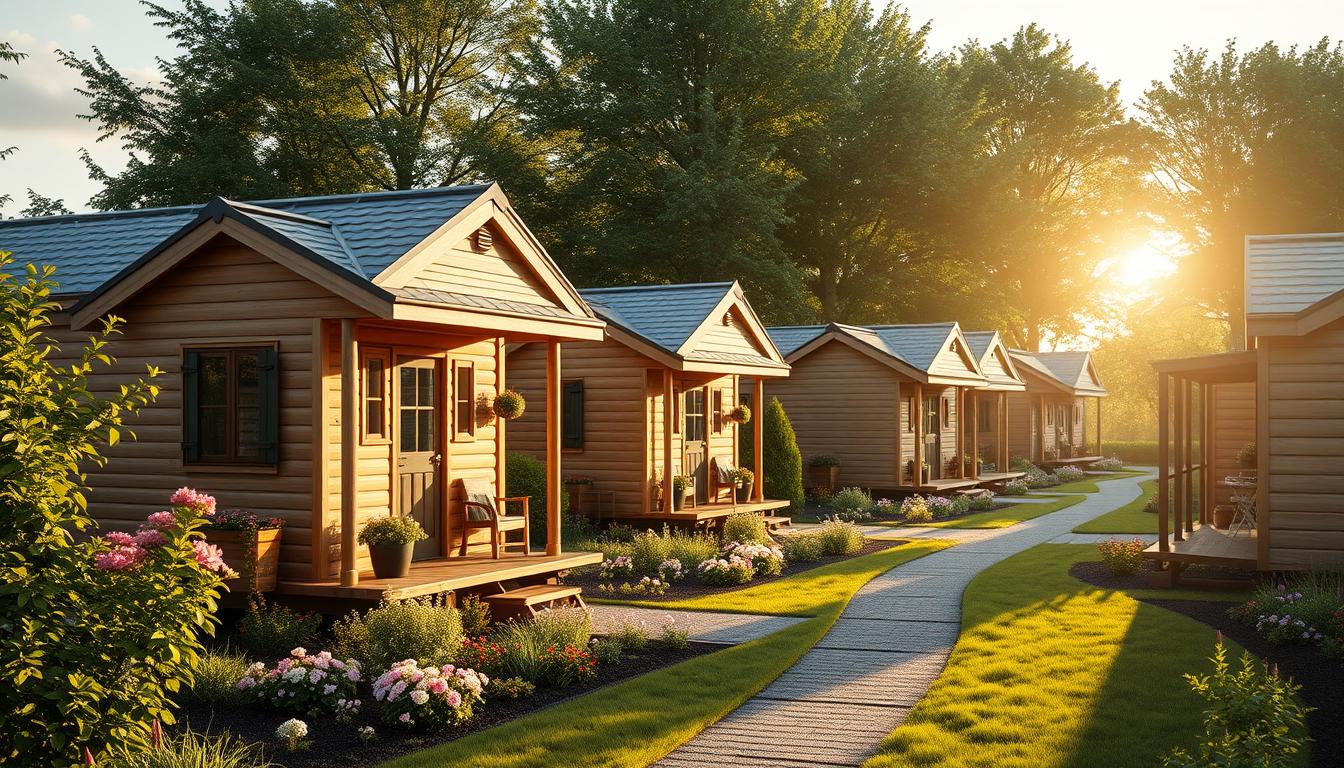The UK’s housing market is tough, especially for seniors. By 2050, one in four people will be over 65. This means more seniors need homes that are easy to get around and affordable. Sadly, only 9% of homes in the UK are accessible, leaving many seniors in unsuitable homes.
This situation affects their quality of life and costs the NHS up to £1.4 billion a year. It’s a big problem.
Senior tiny home communities are a new solution. These homes are small and easy to get around, helping seniors live on their own. They also create a supportive community. The tiny home movement in the UK is growing because it’s a smart, affordable way for seniors to downsize.
Small changes to homes can save a lot of money on healthcare. Every £1 spent on home improvements could save up to £7. This shows how important good housing for seniors is. It can save money and improve health.
Projects like these tiny home communities show that quality housing for seniors is possible and needed.
Key Takeaways
- The UK’s senior population is rapidly growing, necessitating more accessible housing options.
- Only 9% of homes in the UK meet accessibility standards.
- Senior tiny home communities offer space-efficient, independent living solutions.
- Preventative home improvements can save significant healthcare costs.
- Tiny home communities promote sustainability and social interaction.
The Rise of Senior Tiny Home Communities
The housing market is changing, and senior tiny home communities are popping up all over the UK. These communities are designed for the elderly, offering a smaller and more manageable living space. Choosing small homes for elderly people helps them live sustainably and reduce their environmental impact.
Benefits of Tiny Home Living for Seniors
Seniors moving to tiny homes enjoy many benefits. The smaller size is easier to keep clean, which is great for those with mobility issues. These homes also have wider doors and accessible bathrooms for safety. Plus, they simplify life, letting seniors focus on their well-being and connecting with others.
Living in tiny home communities also helps seniors build strong bonds with their neighbours. The design of these communities encourages social interaction and support. Studies show that positive social interactions can make older adults happier and more satisfied with life.
Environmental and Economic Advantages
Choosing eco-friendly tiny homes is good for the planet and can save money. They use less energy and resources than big houses, which is better for the environment and cuts down on utility bills. Solar panels and community gardens add to the sustainable lifestyle.
Tiny homes are also cheaper than regular houses, costing between £20,000 and £80,000. This makes them an affordable choice for many seniors. They offer a way to enjoy retirement without worrying about big mortgages or maintenance costs. Tiny homes also help ease the pressure on the housing market, providing a practical solution for senior housing.
In summary, the growth of senior tiny home communities marks a shift towards more sustainable and cost-effective living. These homes are not just practical for the elderly but also promote eco-friendly living. They are perfect for those wanting to downsize and simplify their retirement years.
Why the UK Needs More Senior Housing Options
The UK’s population aged 75 and over is set to grow by 38% by 2040. This means millions more seniors will need proper housing. Yet, the current market struggles to meet this demand.
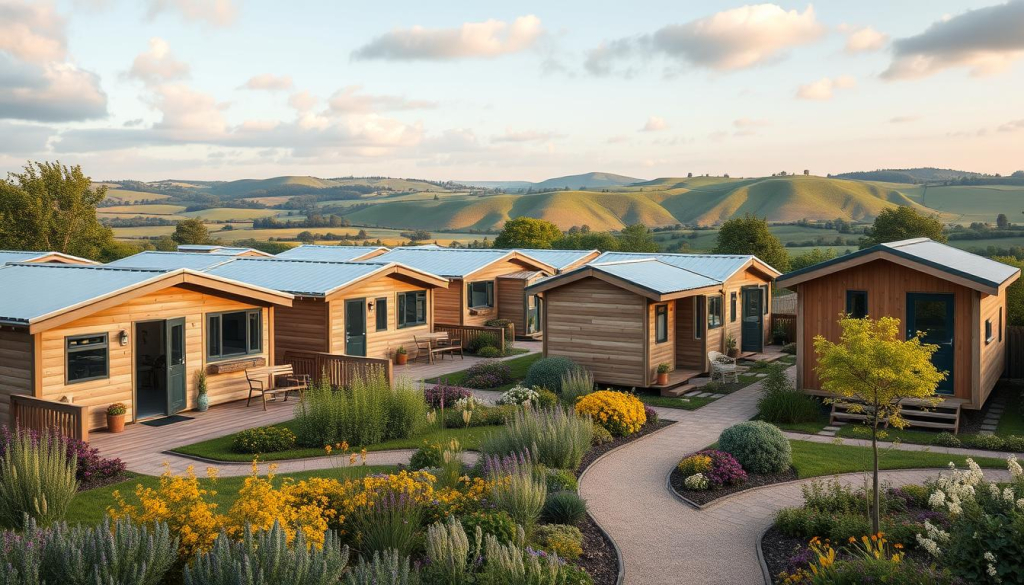
Recently, Integrated Retirement Communities (IRCs) have seen a 19% increase in units. This shows they are becoming more popular. However, the gap between the demand for affordable housing and what’s available is growing. Today, there are 771,848 units, but a shortfall of up to 46,000 homes is expected in the next five years.
In 2023, IRCs house around 120,000 seniors, making up 12% of the seniors housing stock. They are growing at 3.6% annually. This shows a shift towards independent living among the elderly.
The UK’s ageing population is a challenge and an opportunity. Seniors need quality, affordable housing that supports independent living. Currently, there are 884,000 residents in 23,853 retirement housing schemes. Yet, only 31,523 units were delivered in the last five years, which is not enough.
There’s also a big issue with housing affordability. Only 0.5% of senior housing is market rent, compared to 20% in the wider market. With only 36,700 units planned for completion by 2029, we face a shortfall of 31,500 units.
Having enough senior housing is key for the well-being of the elderly and the health system. We need more affordable, independent living solutions. Addressing this issue quickly is vital to support the UK’s ageing population.
Features of Ideal Senior Tiny Homes
For seniors, having a home that meets their needs is key. The perfect tiny home for seniors should be accessible and adaptable. It should also help seniors feel part of a community and encourage social interaction.
Accessibility and Adaptability
Creating accessible tiny homes involves careful design. Wide doorways, no-step entries, and grab rails make homes safer and more comfortable. It’s also important to include features for seniors with mobility issues.
By using universal design, like slip-resistant floors and lever handles, homes become safer for everyone. This makes tiny homes functional and safe for all.
Space-saving ideas are crucial in adaptable housing for seniors. Multi-functional furniture and flexible living areas help seniors stay independent. Kitchens and bathrooms that are easy to use are also essential.
Getting advice from experts and following legal standards, like those in Australia, helps create homes that are safe and suitable for seniors.
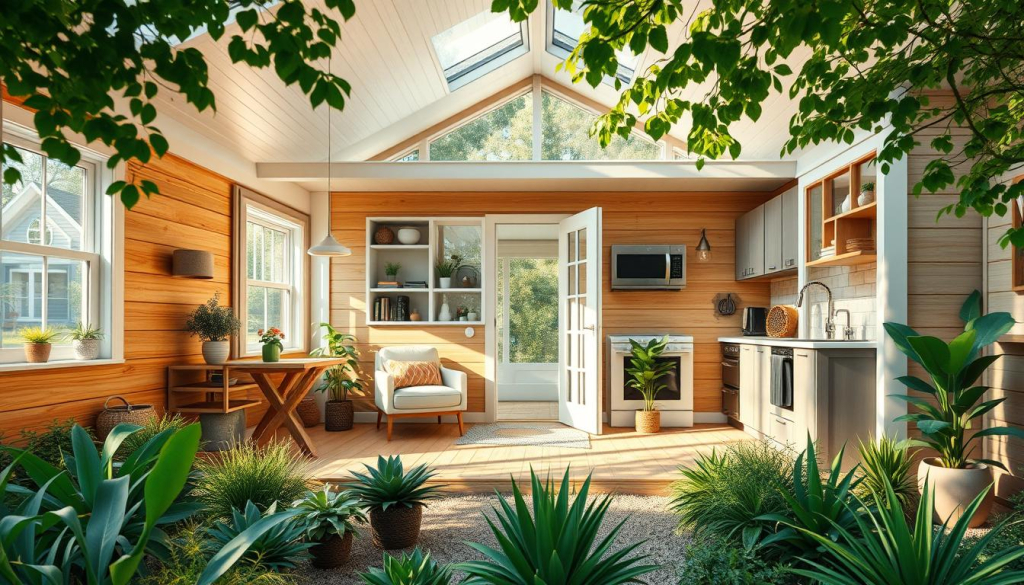
Community and Social Interaction
A sense of community is vital for senior community living. Designing homes with spaces for socialising helps combat loneliness. Shared areas like kitchens, gardens, or rooms for fun activities encourage seniors to connect and form friendships.
This social connection is key for their mental health and wellbeing. Tiny home developers, like Havenn Tiny Houses, show how important it is to focus on accessibility and community.
By doing so, they help seniors live in supportive and enriching places. This allows them to enjoy their later years fully.
Examples of Successful Tiny Home Communities
Tiny homes are becoming popular in the UK, especially among seniors. They like the simplicity and green living. Marmalade Lane in Cambridge is a top example. It’s a successful senior community with modern homes and a lively community.
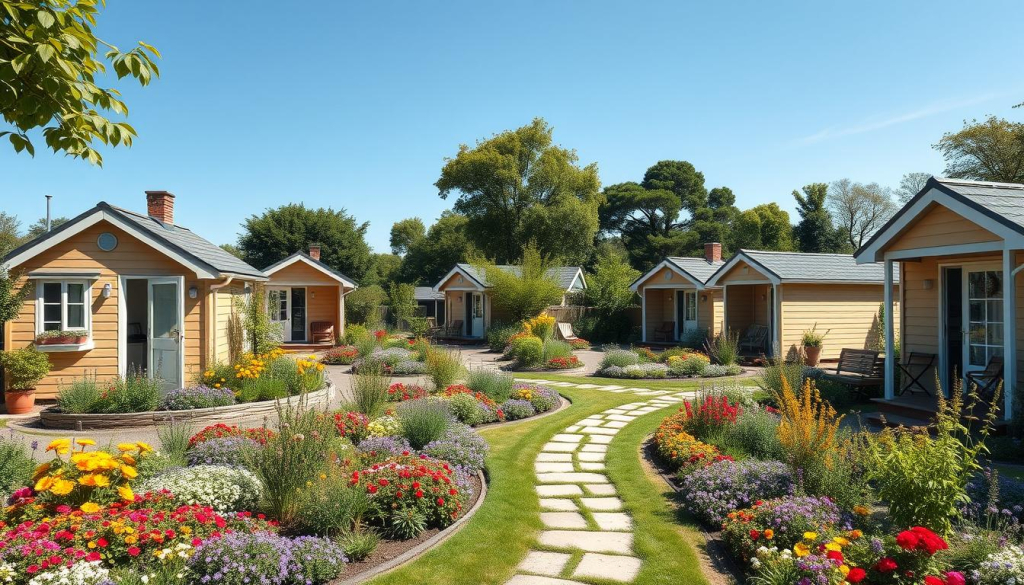
Marmalade Lane shows how tiny homes can be private yet social. It has shared spaces like kitchens, gardens, and lounges. These areas help residents feel connected, which is key in 85% of UK senior tiny home communities.
The community is also eco-friendly, which seniors love. It’s designed to save energy and protect the environment. This makes it a model for future senior projects, showing the benefits of tiny homes.
LuxTiny in the Lakeside village is another great example. It has green features like chicken coops and solar panels. Bluegrass Tiny Ridge in Kentucky is also designed for adults, offering a fun and engaging lifestyle. These tiny homes are becoming popular among seniors for their compact and manageable living spaces.
In the UK, there’s a 25% increase in seniors wanting smaller homes. Communities like Marmalade Lane are becoming more common. They offer practical, green living and support for older residents. This is perfect for the 18% of the UK’s population aged 65 and over, who want a simpler and more connected life.
Steps to Downsizing: Moving into a Senior Tiny Home
Starting a new life in a senior tiny home is exciting. It’s a chance to live simply and efficiently. Downsizing for seniors means planning carefully to make the move easy. We’ll cover the key steps and financial tips for living in a tiny home.
Planning and Preparation
Choosing a senior tiny home means decluttering and simplifying. Think about what to keep, what to donate, and what to throw away. On average, seniors get rid of 50% of their stuff, making the space cozy and easy to manage.
“Senior move managers can assist with downsizing, moving logistics, and tech setup for new residents in retirement homes, providing specific services tailored to individual needs.”
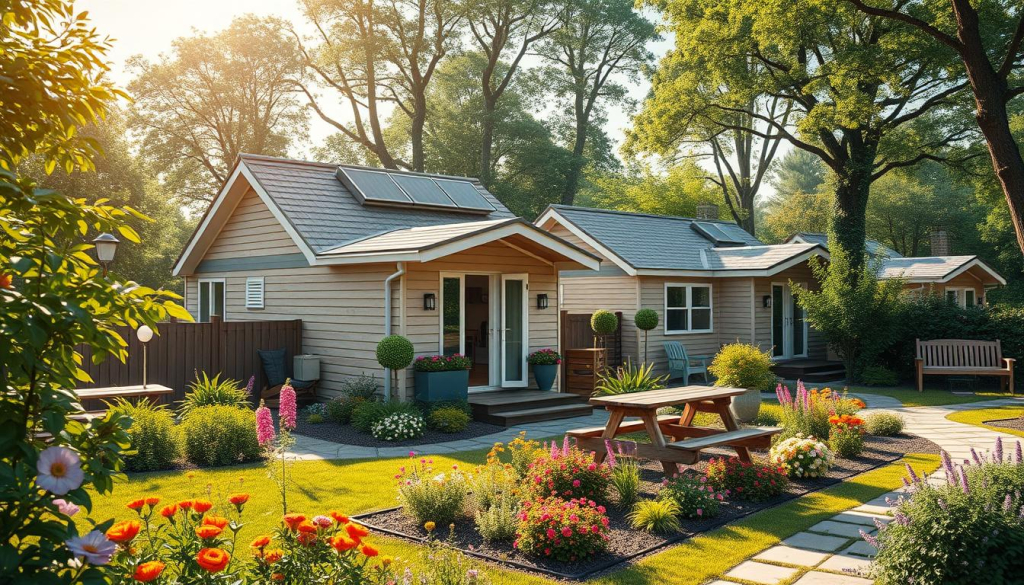
- Measure furniture and layout floor plans accurately to avoid delays and ensure compatibility. Missteps in this area can lead to 20% of all moving complications.
- Consider multi-functional furniture to maximize space efficiency. Many seniors opt for pieces that serve dual purposes.
- Engage with professional organisers who offer services like sorting and packing, making the downsizing for seniors less stressful.
Financial Considerations
Planning your finances for a tiny home is crucial. The initial cost is high, but long-term savings are big. Tiny homes use less energy and need less maintenance, saving money and increasing disposable income by about 25% for retirees.
Here’s what to remember:
- Evaluate the cost of the move, including any renovations or customisation needed for the tiny home.
- Research potential financial benefits such as reduced council tax and utility savings.
- Seek advice from financial planners experienced in senior living to optimise investments and manage budgets effectively.
Downsizing and financial planning are key for a happy retirement in a tiny home. With good preparation, the move can be rewarding financially and emotionally.
Government Role in Promoting Age-Restricted Neighbourhoods
The UK government plays a big role in helping senior tiny home communities grow. They support policies that make age-restricted areas better for seniors. This ensures seniors have safe, affordable places to live.
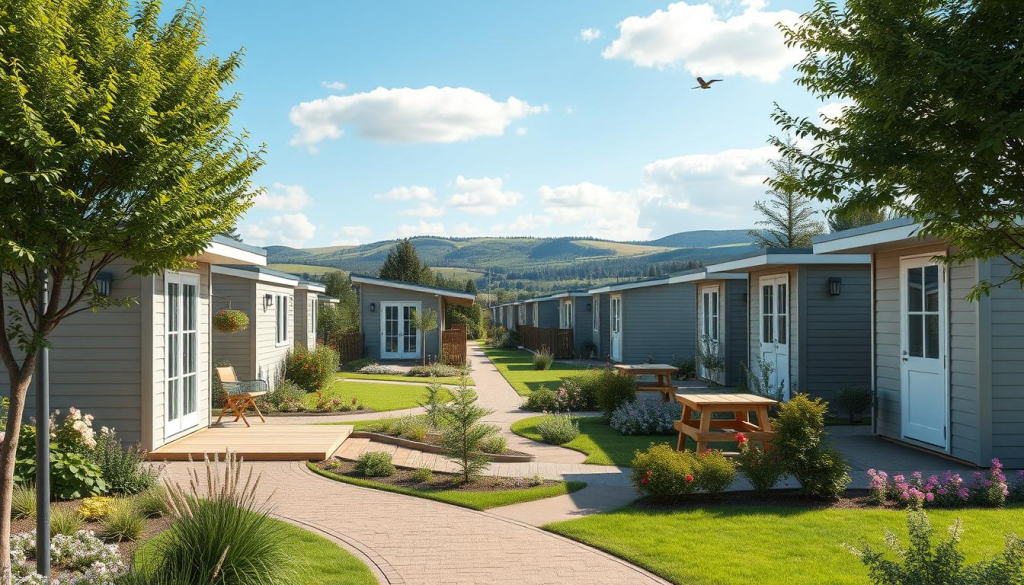
It’s key for the government to help age-restricted areas thrive. They have rules and programmes that make these places better for older people. These focus on making living spaces easy to use and adapt to.
Policies and Regulations
Rules like retirement village regulations make building easier. They ensure places are up to standard for seniors. Tools like SHOP@ help plan for the right amount of housing.
Government policies also guide developers. They make sure homes are accessible and can change as needed.
Supportive Programmes and Incentives
Government incentives are also important. They offer tax breaks, grants, and help for seniors to downsize. This encourages more housing for seniors.
Programmes like Personal Independence Payment help with home changes. This ensures homes stay suitable as seniors’ needs change. These efforts are key to growing senior communities.
Local authorities should have clear plans for senior housing. They should track progress to make sure goals are met. With more seniors, having the right housing is more urgent than ever.
Accessible housing means seniors can live independently. It also saves money on health and social care costs. This is a smart way to meet the nation’s housing needs for seniors.
Conclusion
Senior tiny home communities are a great answer to the UK’s housing crisis for the elderly. They offer affordable, green retirement options. Seniors can save money, live more sustainably, and feel part of a tight-knit community.
Prices for tiny homes range from £30,000 to £100,000. This makes them a budget-friendly choice for many retirees. It can greatly improve their quality of life.
To make these communities thrive, everyone needs to work together. The government, private sector, and planners must support tiny homes. They should help tiny homes fit into both cities and countryside.
For example, Bristol is building up to 15 tiny houses on a former council site. This shows we need new housing ideas to solve our problems.
Increasing awareness of tiny home benefits is key to moving forward. Projects like Cornwall Council’s SoloHaus units in Truro show their potential. They help seniors live healthier, happier lives.
By adopting these green retirement options, we tackle housing issues now. We also build a better community for the future.


